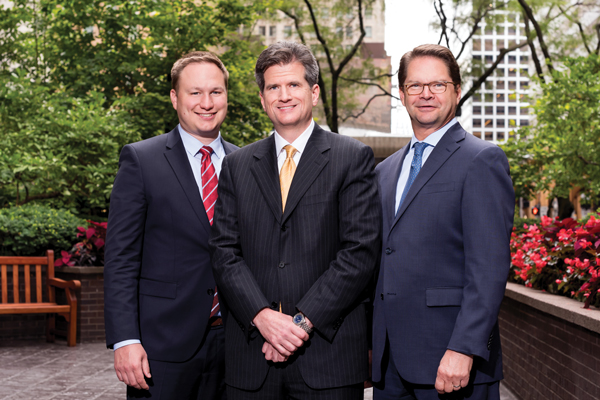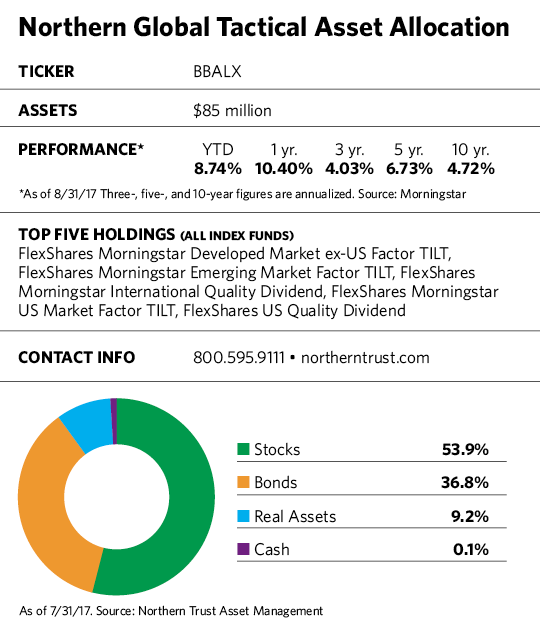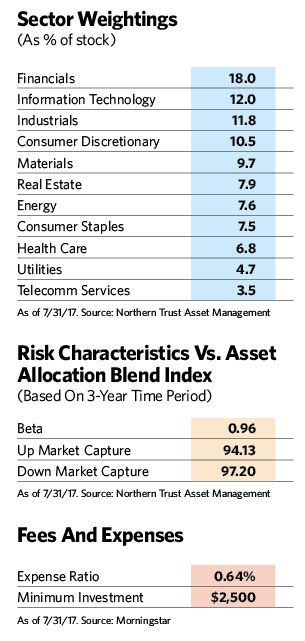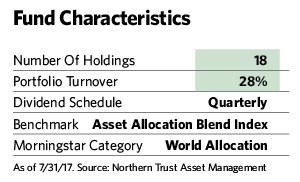Shifting Overseas Brexit, threats from North Korea, political upheaval in the U.S., and other recent geopolitical events have been putting investors on edge and creating spikes in market volatility. Add elevated market valuations to the mix, and it might seem like a recipe for stock market mayhem.
Brexit, threats from North Korea, political upheaval in the U.S., and other recent geopolitical events have been putting investors on edge and creating spikes in market volatility. Add elevated market valuations to the mix, and it might seem like a recipe for stock market mayhem.
 But market rumblings don’t necessarily translate into a rout, says Jim McDonald, who manages the Northern Global Tactical Asset Allocation fund (BBALX) with Bob Browne and Daniel Phillips. “In the 14 years I’ve chaired the tactical asset allocation committee, I’ve learned that geopolitical events rarely have a sustained impact,” he says. “It would take a relatively extreme outcome, such as a trade war with China or actual military engagement with North Korea, to justify a change in tactical asset allocation policy.” Those views are supported by a report from Northern Trust Asset Management, which says that market declines stemming from so-called “crisis” events—such as Iraq’s invasion of Iran or the Asian currency crisis—lasted an average of eight days, and that the markets then took an average of 37 days to recover to pre-crisis levels.
But market rumblings don’t necessarily translate into a rout, says Jim McDonald, who manages the Northern Global Tactical Asset Allocation fund (BBALX) with Bob Browne and Daniel Phillips. “In the 14 years I’ve chaired the tactical asset allocation committee, I’ve learned that geopolitical events rarely have a sustained impact,” he says. “It would take a relatively extreme outcome, such as a trade war with China or actual military engagement with North Korea, to justify a change in tactical asset allocation policy.” Those views are supported by a report from Northern Trust Asset Management, which says that market declines stemming from so-called “crisis” events—such as Iraq’s invasion of Iran or the Asian currency crisis—lasted an average of eight days, and that the markets then took an average of 37 days to recover to pre-crisis levels.
McDonald, who is also the firm’s chief investment strategist, believes that the uncertainty amid such events will fade over the next year. “At the end of the day, the actors involved in the different political theaters will do what is rational,” he says. And over the longer term, more stringent financial and banking regulations implemented since the financial crisis should help us avoid another 2008-style debacle. “Some recent efforts to reduce financial constraints are warranted and can be good for growth without creating new financial risk,” he maintains.
Elevated stock market valuations, especially in the U.S., are also giving investors pause. Over the past five years, the MSCI World Index (a proxy for the developing world) has seen its price to trailing-12-month earnings rise from 13.7 to 21.5 times.
McDonald, however, says a number of factors will help keep those values holding firm—factors such as slow but steady economic growth, benign inflation and low interest rates. The higher valuations are also more justified because pricier sectors such as technology now make up a greater proportion of the indexes than they did before. The movement of assets into exchange-traded funds could further prop up values and keep retail investors in the market during times of volatility.
 Nor does investor sentiment suggest that the market is in a bubble. Instead of the blind optimism that signals bubbles, anecdotal accounts suggest to McDonald that investors are in fact skeptical of the ongoing market rally.
Nor does investor sentiment suggest that the market is in a bubble. Instead of the blind optimism that signals bubbles, anecdotal accounts suggest to McDonald that investors are in fact skeptical of the ongoing market rally.
Along with these reassurances come more modest return expectations. The firm’s latest five-year outlook calls for annualized five-year stock market returns of 5.9% in the U.S., 7.2% in Europe, 8.4% in emerging markets and 6% in Japan. Those numbers are quite a bit lower than they’ve been in the recent past. For the five years ended June 30, 2017, the average annualized returns were 14.6% for the U.S., 14% for Europe, 8% for emerging markets and 17.6% for Japan.
Unlike many money managers, who have fairly rigid allocation parameters and aren’t particularly attuned to macroeconomic events, McDonald and his team take a decisive stand on broad global trends and tailor investment strategies accordingly in the Global Tactical Asset Allocation fund. They also keep things simple by using a dozen or so ETFs, rather than hundreds of individual securities, to implement their strategies. Most of these funds are Northern Trust FlexShares products, and those that use equities have tilts toward factors such as companies’ dividend payments, value, quality or size.
McDonald says the firm uses ETFs because they’re economical and easy to trade. Because the factor tilts tend to be cyclical, since some do well while others do poorly, the aim is to reduce volatility and outperform market-cap-weighted indexes over the long term. This year, for example, the size and value factors have detracted from performance (although they have been a plus over the long term), while the quality and dividend factors have benefited international stock holdings.
Aside from its use of ETFs, the Northern Global Tactical Asset Allocation fund stands apart from other world allocation funds in other respects. Unlike many of its peers, it devotes a small portion of the portfolio to “real assets” such as real estate and natural resources. Its 0.64% expense ratio is well below the 1.05% expense ratio for the average fund in Morningstar’s world allocation group. The fund also has much lower stock turnover than its peers at about 28% per year.
With just $85 million in assets, the fund is dwarfed by much larger competitors such as the American Funds Capital Income Builder fund (CAIBX), which has $105 billion, and the BlackRock Global Allocation fund (MDLOX), which has $39 billion. Nonetheless, as David Snowball noted in a Mutual Fund Observer article earlier this year, the fund’s “returns have been higher than most [of its peers’] across the full market cycle, its downside risk has been the lowest in the group and its Sharpe ratio—a measure of risk-adjusted returns—is the second highest in the group. ... It has used its flexibility and low expenses to outperform some very distinguished competition.”

The investment foundation for both the fund and the firm’s institutional clients is a strategic asset allocation plan that Northern Trust Asset Management’s investment committee generates each year, as well as the estimated five-year forward returns for various asset categories. During the year, the firm adjusts those allocations monthly to create a “tactical” allocation strategy that takes advantage of market opportunities and avoids potential pitfalls. Essentially, the fund is a public proxy for the asset allocation recommendations that Chicago-based Northern Trust Asset Management provides its institutional clients across most of its $1 trillion in assets under management.
Shifting To International Equities
October 2, 2017
« Previous Article
| Next Article »
Login in order to post a comment








